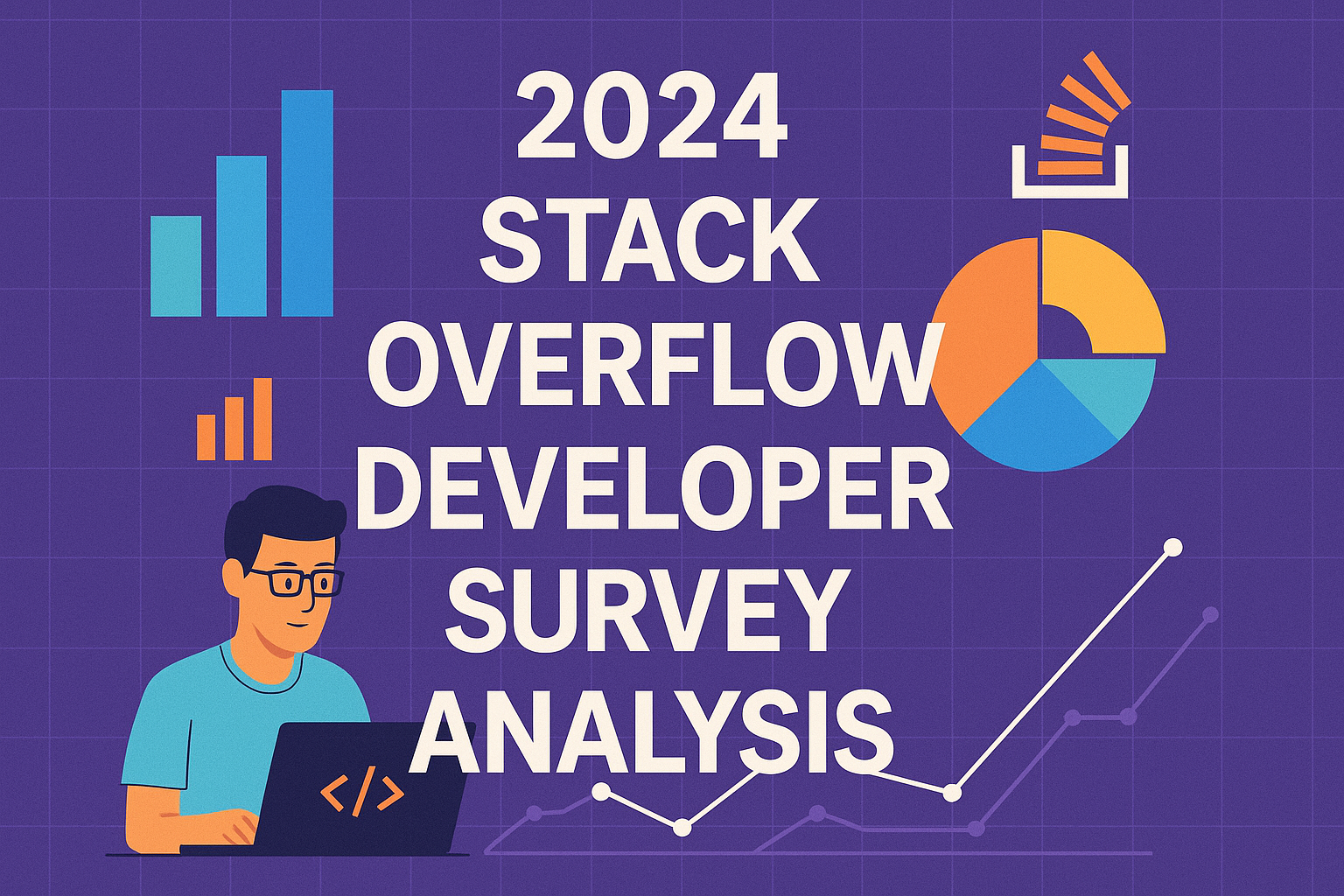
Unlocking Insights into AI Adoption, Salary Trends, and Developer Productivity
Welcome to the 2024 Stack Overflow Developer Survey Analysis! In this project, I explore developer trends, technology adoption, AI integration, and job satisfaction using insights from over 65,000 developers worldwide.
Through data cleaning, exploratory analysis, and visualisation, I uncover key insights into how developers work, learn, and interact with AI & Stack Overflow.
📝 Introduction
Why This Project?
The Stack Overflow Developer Survey is one of the largest and most comprehensive datasets on software development. By analysing this dataset, we can:
✅ Identify the most popular programming languages & tools.
✅ Understand how AI is shaping developer workflows.
✅ Explore salary trends & job satisfaction.
✅ Identify developer frustrations & challenges.
📊 Dataset Overview
📥 Data Source:
🔗 The dataset was downloaded from Stack Overflow's Official Survey
📂 Structure of the Dataset:
- 65,437 responses from developers worldwide 🌍
- 114 columns covering
- 🌐 Programming languages, frameworks, and tools
- 🤖 AI adoption & trust in AI-generated code
- 💰 Salaries & job satisfaction
- 🚀 Learning resources & Stack Overflow usage
🛠️ Data Cleaning & Preprocessing
🔎 Steps Taken:
1️⃣ Checked for Missing Values
- Many columns had high missing values (e.g.,
AINextMuch less integrated,EmbeddedAdmired). - Dropped columns with >50% missing data.
- Filled missing categorical values with
"Unknown". - Filled missing numerical values with median values.
2️⃣ Checked for Duplicates
- Removed all duplicate rows to avoid redundancy.
3️⃣ Fixed Data Types
- Converted salary & experience fields to numeric values.
- Standardised categorical values (e.g.,
"Yes","yes","YES"→"yes").
4️⃣ Ensured Data Consistency
- Fixed multi-select fields (e.g., split languages & tools into separate counts).
📈 Exploratory Data Analysis (EDA)
1️⃣ Developer Demographics
📌 Age Distribution
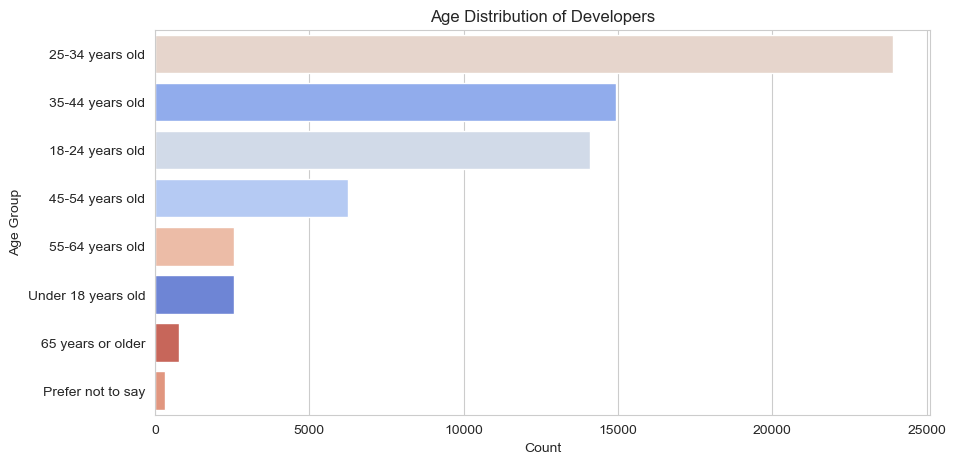
Age Distribution for Developers
- Most developers are aged 18-34 years.
- For older developers, showing a younger workforce in tech.
📌 Education Level
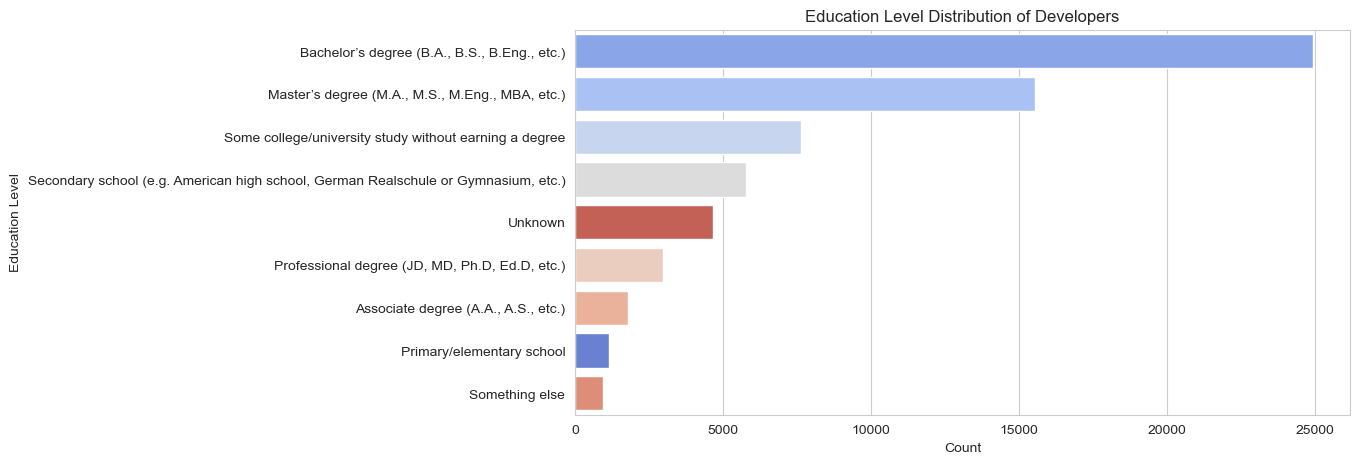
Education Level distribution of Developers
- Majority hold a Bachelor’s or Master’s degree. 🎓
- Some self-taught developers & bootcamp graduates.
2️⃣ Popular Programming Languages & Frameworks
📌 Most Used Languages
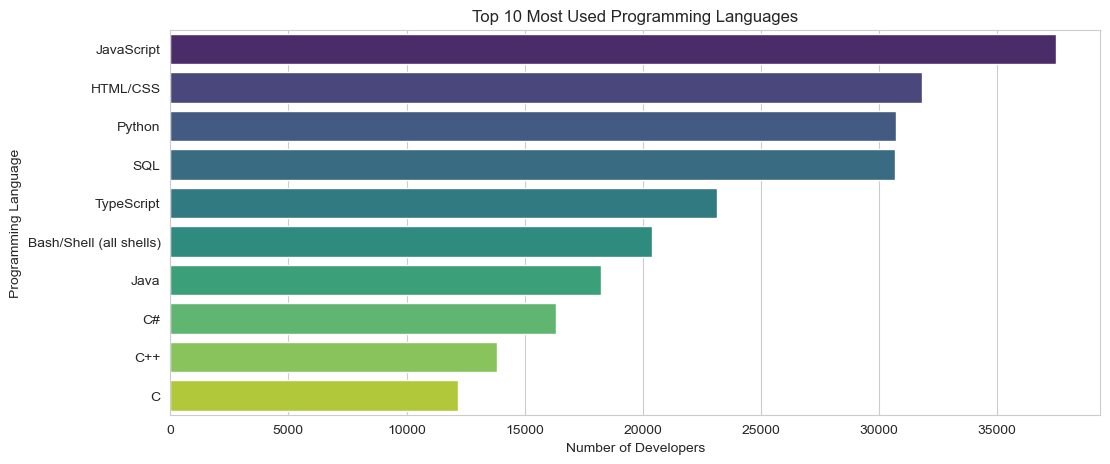
Top 10 Most Used Programming Language
- Python, JavaScript, and SQL remain the top languages.
- Rust, Go, and TypeScript are gaining popularity.
📌 Most Wanted Languages
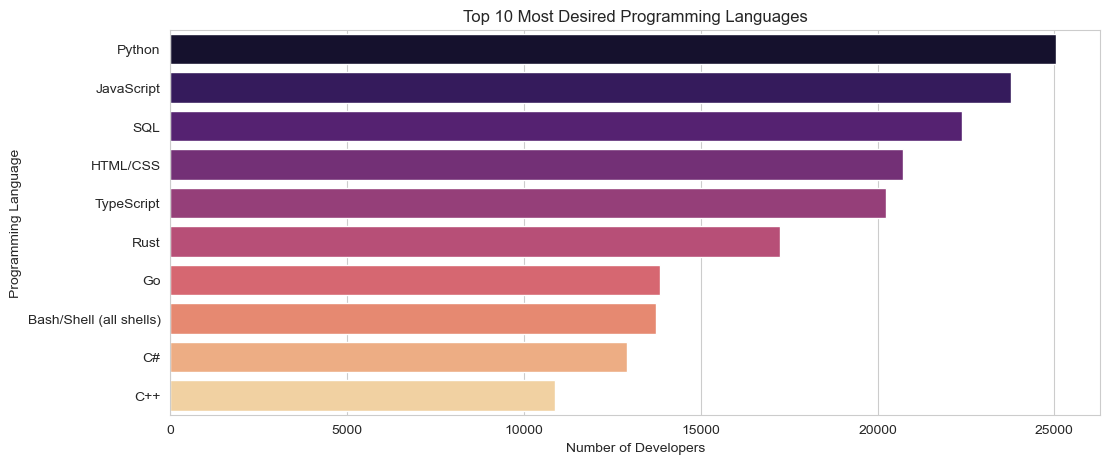
Top 10 most Desired Programming Language
- Developers want to learn Rust, TypeScript, and Go.
3️⃣ AI Usage & Trust in AI
📌 AI Integration in Development

Developers using Ai in their workflow
- 75% of developers use AI-powered tools (ChatGPT, Copilot).
- Trust in AI varies—some rely on AI, others are sceptical.
- Some developers worry AI will replace jobs. 🤖💼
4️⃣ Developer Frustrations & Productivity Challenges
📊 Word Cloud of Developer Frustrations
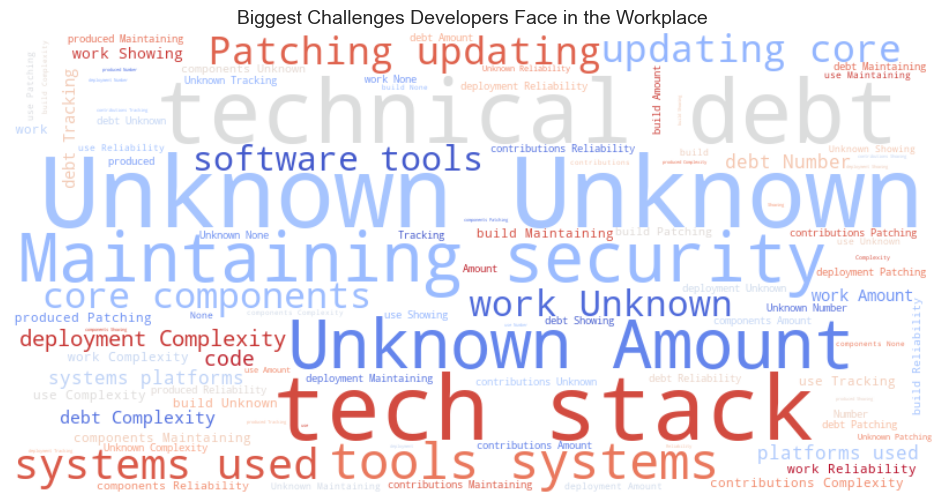
Challenges faced by programmers - Wordcloud
- "Poor documentation," "tight deadlines," and "legacy code" are common frustrations.
- Many developers spend 30-60 minutes daily searching for solutions.
5️⃣ Stack Overflow Usage & Learning Trends
📌 How Do Developers Learn?
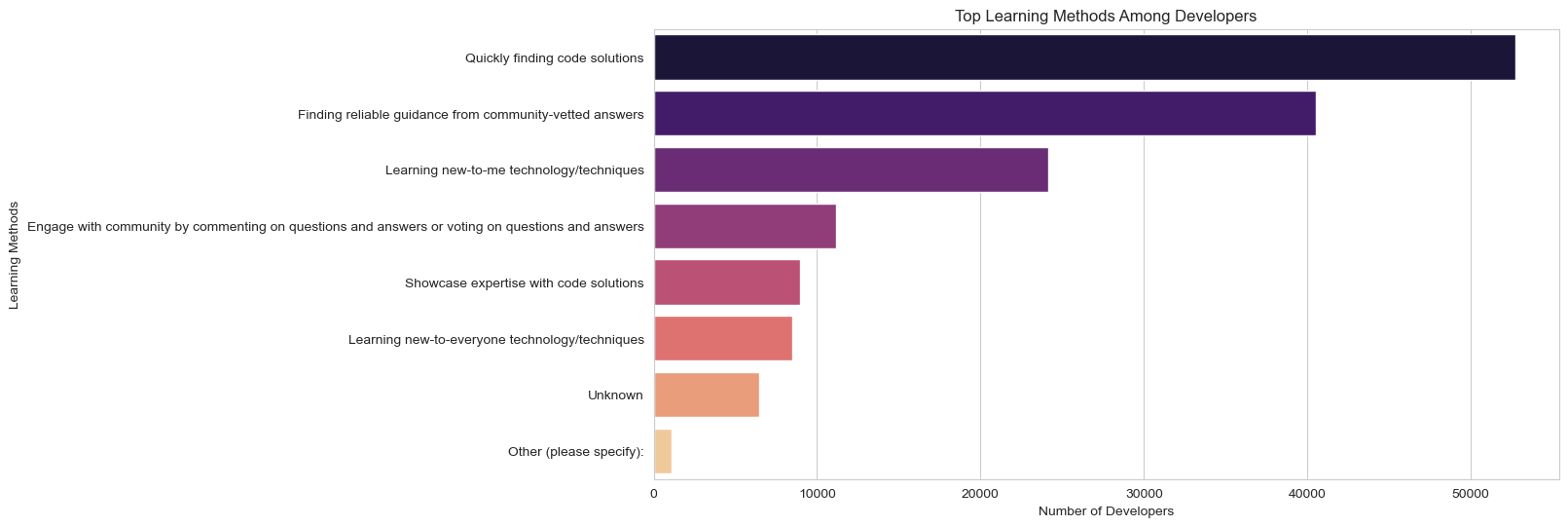
Top Learning Methods Among Developers
- Most rely on Stack Overflow, online courses, and documentation. 📚
- AI-powered learning tools are growing in adoption.
📌 How Often Do Developers Visit Stack Overflow?
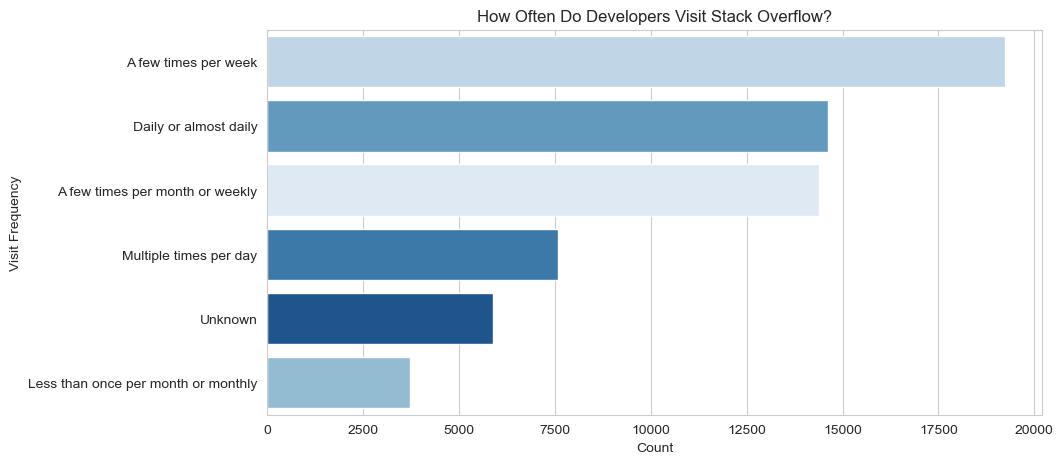
How often do developers visit stack overflow
- 50% visit daily or multiple times per day.
- Some rely on private documentation instead.
💡 Conclusion & Insights
- AI is transforming development, but trust in AI remains mixed.
- Python, JavaScript, and SQL remain dominant, but Rust & TypeScript are the future.
- Salaries increase with experience but plateau after 20+ years.
- Developers face major challenges with tight deadlines & outdated code.
- Stack Overflow & online courses are still essential learning resources.
📌 How to Use This Project?
💻 Requirements
- Python
- Jupyter Notebook
- Libraries: pandas, seaborn, matplotlib, wordcloud
📜 Run the Notebook:
- Clone this repository
- Install required libraries (pip install pandas seaborn matplotlib wordcloud)
- Run jupyter notebook and open the .ipynb file
- Execute the cells to see the analysis
🎯 Next Steps
🔹 Perform machine learning predictions (salary prediction, clustering).
🔹 Use Natural Language Processing (NLP) for sentiment analysis on developer frustrations.
🔹 Compare 2024 data with previous years to identify trends.